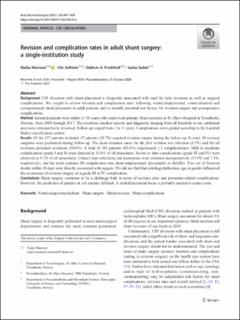| dc.contributor.author | Mansoor, Nadia Mauland | |
| dc.contributor.author | Solheim, Ole | |
| dc.contributor.author | Fredriksli, Oddrun | |
| dc.contributor.author | Gulati, Sasha | |
| dc.date.accessioned | 2021-04-26T13:15:47Z | |
| dc.date.available | 2021-04-26T13:15:47Z | |
| dc.date.created | 2020-11-02T22:41:19Z | |
| dc.date.issued | 2020 | |
| dc.identifier.citation | Acta Neurochirurgica. 2020, 163 1-8. | en_US |
| dc.identifier.issn | 0001-6268 | |
| dc.identifier.uri | https://hdl.handle.net/11250/2739679 | |
| dc.description.abstract | Background: CSF diversion with shunt placement is frequently associated with need for later revisions as well as surgical complications. We sought to review revision and complication rates following ventriculoperitoneal, ventriculoatrial and cystoperitoneal shunt placement in adult patients, and to identify potential risk factors for revision surgery and postoperative complications. Method: Included patients were adults (≥ 18 years) who underwent primary shunt insertion at St. Olavs Hospital in Trondheim, Norway, from 2008 through 2017. The electronic medical records and diagnostic imaging from all hospitals in our catchment area were retrospectively reviewed. Follow-up ranged from 1 to 11 years. Complications were graded according to the Landriel Ibañez classification system. Results: Of the 227 patients included, 47 patients (20.7%) required revision surgery during the follow-up. In total, 90 revision surgeries were performed during follow-up. The most common cause for the first revision was infection (5.7%) and for all revisions proximal occlusion (30.0%). A total of 103 patients (45.4%) experienced ≥ 1 complication(s). Mild to moderate complications (grade I and II) were detected in 35.0% of all procedures. Severe or fatal complications (grade III and IV) were observed in 8.2% of all procedures. Urinary tract infections and pneumonia were common postoperatively (13.9% and 7.3%, respectively), and the most common IIb complication was shunt misplacement (proximally or distally). Two out of fourteen deaths within 30 days were directly associated with surgery. We did not find that aetiology/indication, age or gender influenced the occurrence of revision surgery or a grade III or IV complication. Conclusions: Shunt surgery continues to be a challenge both in terms of revision rates and procedure-related complications. However, the prediction of patients at risk remains difficult. A multidimensional focus is probably needed to reduce risks. | en_US |
| dc.language.iso | eng | en_US |
| dc.publisher | Springer | en_US |
| dc.rights | Navngivelse 4.0 Internasjonal | * |
| dc.rights.uri | http://creativecommons.org/licenses/by/4.0/deed.no | * |
| dc.title | Revision and complication rates in adult shunt surgery: a single-institution study | en_US |
| dc.type | Peer reviewed | en_US |
| dc.type | Journal article | en_US |
| dc.description.version | publishedVersion | en_US |
| dc.source.pagenumber | 1-8 | en_US |
| dc.source.volume | 163 | en_US |
| dc.source.journal | Acta Neurochirurgica | en_US |
| dc.identifier.doi | 10.1007/s00701-020-04526-z | |
| dc.identifier.cristin | 1844332 | |
| cristin.ispublished | true | |
| cristin.fulltext | original | |
| cristin.qualitycode | 1 | |

